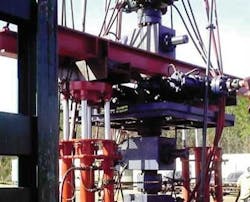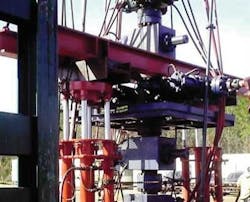First automated MPD in Mexico GoM cuts drilling days
Luis Giral
German Castiblanco
Weatherford International Ltd.
Drilling in the fractured carbonate formations of the Gulf of Mexico typically poses many challenges to risk management, safety, and drilling efficiency. Significant nonproductive-time (NPT) is generated by lost circulation and/or gas influxes in the high-pressure formations, and a host of related problems. In some cases, the conditions are so overwhelming that the hole is undrillable using conventional means and must be abandoned.
These difficult issues have been successfully addressed in the first use of automated managed pressure drilling (MPD) in the GoM. By measuring and managing bottomhole wellbore pressures in real time, the MPD system enabled a proactive response to downhole influxes and losses that greatly reduced hole problems and improved safety. The performance enhancements resulted in successfully drilling the designed hole size to target depth 12 days faster than the best offset.
Land and offshore drilling operations along Mexico’s Tabasco coast face major difficulties posed by variations in pore pressures and fracture gradients, depleted reservoirs, and highly fractured carbonates. The fractured carbonate formations present negative drilling windows where pore pressure and fracture pressure overlap, resulting in entire sections experiencing complete circulation losses.
The offshore development well selected for application of Weatherford’s MPD monitoring, analysis, and management system is about 27 m (89 ft) of water. Offset wells had experienced considerable cost-increasing NPT due to a variety of operational problems, including lost circulation and gas influxes (sometimes simultaneously), difficulty identifying washout and ballooning events, differential sticking, the presence of hydrogen sulfide (H2S) gas, low penetration rates, and formation damage.
MPD objectives
The primary objective of using the automated MPD system was to reach the target depth with the planned 8½-in. hole while incurring as little NPT as possible through the reservoir section. The operational strategy was based on three key MPD capabilities: using a lower mud weight, real-time monitoring of small variations in bottomhole pressure, and proactive management of those pressure changes to prevent them from escalating into well control events.
Mud weight was reduced to enhance the rate of penetration (ROP). Conventional drilling operations typically use a heavier mud weight as a necessary safety margin because they depend on estimates of pore pressure rather than actual data acquired while drilling. Real-time monitoring and management of losses and influxes facilitate the use of a mud weight closer to optimal weight without compromising safety.
A lower-density mud also allows for easier control or elimination of fluid losses when entering weak formations. And when drilling in the reservoir, a lighter mud reduces skin damage that can limit the well’s production potential.
Improved drilling operations
Results from the MPD well compared to two offset wells clearly show the success of the application. With MPD, the 8½-in. hole section was drilled in 26 days versus 38 and 59 days for the offsets, saving 12 and 33 days respectively. ROP averaged 5-6 m/hr while the offsets managed only 1-2 m/hr. The MPD well also required fewer bits (three) that the offsets which required six and eight bits.
MPD operations began with a lower-density mud than the offsets and averaged a lower weight throughout the drilling. The inverse emulsion mud weight ranged from 1.58 to 1.96 gr/cc in the first offset well and from 1.05 to 1.96 gr/cc in the second. In the MPD well, it averaged 1.49 to 1.68 gr/cc.
Kick and loss mitigation benefited from real-time detection and management of very small volume influxes.
Operational highlights
The MPD operation began with a pressure test of all of the MPD surface equipment. The bottomhole assembly (BHA) – consisting of an 8½-in. polycrystalline diamond compact drill bit, 6 ¾-in. x 8 ½-in. stabilizers, 6½-in. drill collars, a 5-in. heavyweight drill pipe and a 5-in. drill pipe – was lowered into the well.
Once the assembly was 50 m above the shale, the automated system was tested inside the casing before lowering the accessories. The objective of this procedure was to calibrate the response of the system to influxes, losses, equivalent circulating density (ECD) control, swabbing, and surging. The casing shoe was drilled out when the calibration was complete.
Drilling of the 8½-in. section began at 4,375 m with a mud density of 1.65 gr/cc and a flow rate of 330 gpm, for an ECD of 1.70 gr/cc. The mud density selected for the MPD operation was 0.15 gr/cc lower than the conventional figure of 1.80 gr/cc.
The automated system began in standard mode, with the chokes fully open, monitoring the entrance and exit flow to respond to any unexpected event. Essentially, the strategy was to wait until the well “spoke” before making decisions in accordance with the density and bottomhole circulating pressure (BHCP).
One of the events that demonstrated the significant benefit of the automated system was the early identification of a very small influx. At a measured depth of about 4,400 m, the automated system detected an influx of only 1.5 bbl. The influx was controlled in less than 2 min.
The system identifies a gas influx while drilling at 4,426 m. Because of the early kick detection capabilities of the system, the pit gain was only 1.5 bbl.
The Microflux system detected an increase in outflow compared to inflow. Based on internal algorithms, the system indicated to the MPD choke to adjust automatically. The application of back pressure equalized the inflow and outflow.
The influx that had been incorporated into the mud system was then circulated out by applying 650 psi back pressure. Drilling continued while back pressure was increased to 750 psi, which addressed the safety factor required by the operating company.
This response contrasts with the inevitable NPT resulting from conventional well control procedures and maneuvers that are the only available response when a high-pressure formation is conventionally drilled.
Conventionally, an influx is typically confirmed after a gain of many barrels (typically 10 to 20 bbl). With the constant bottomhole pressure method of MPD, downhole influxes are detected typically at a few barrels and managed quickly before they escalate into a well control event.
After evaluating the situation, it was determined that the options were to continue drilling with this back pressure or to increase the drilling fluid density to reduce it. Considering the risk of finding a new interval with higher pore pressure, it was decided to increase the mud weight from 1.65 gr/cc to 1.68 gr/cc. Back pressure was reduced by 500 psi to continue drilling.
The MPD connection was made at 4,435 m MD to keep the bottomhole pressure constant and to replace the friction losses with back pressure. Drilling continued with a density of 1.68 gr/cc and at a depth of 4,480 m MD, total circulation losses were detected.
In the lower part of the section, the outflow curve moved to the left, indicating total losses. The behavior of the system once gas was detected on the surface is seen in the accompanying illustration. An erroneous reading was seen in the exit flow, which is typical of gas passing through the system. The system generated an alert, signifying the presence of gas on the surface.
Both monitoring and management capabilities are based on the behavior of the incompressible drilling fluid contained within a pressurized closed-loop system. In this environment, a change in bottomhole pressure due to an influx or loss is detected in seconds by surface instruments monitoring the flow and pressure.
Conversely, a change in annular pressure (back pressure) effected by closing an MPD choke or adding fluid via a pump is quickly felt at the bottom of the hole. Small, fast changes in ECD are made easily without changing the mud system or delaying drilling.
In automatic mode, the MPD systems detects rapid fluctuations in downhole pressure, algorithmically processes them and immediately translates the data into changes in annular back pressure necessary to maintain a balance within the drilling window. In this manner, the MPD system manages bottomhole pressure even when the pumps are off while making pipe connections.
MPD technology also reduces the risk of hazardous gas production. Gas influxes are limited by MPD procedures, along with the risk of sour gas release. Any gas getting into the system is small and easily circulated in a controlled manner. The closed-loop system also contains the gas and directs it away from the rig floor.
The MPD equipment spread chosen for the GoM well consisted of several relatively common rig equipment components integrated by the Microflux control system.
A 135⁄8-in. rotating control device (RCD) with a double sealing element was specified for the well. An RCD is the defining component of an MPD operation. Installed on top of the BOP in land or offshore surface applications, the RCD effectively encloses the circulation loop with an elastomeric seal that closes the annulus and redirects the mud system returns. This creates a pressurized closed-loop system that is highly sensitive to pressure changes initiated either downhole or at the surface.
Within this closed-loop system, pressure is managed accurately through application of annular back pressure.
On the GoM well, this back pressure was provided two ways – an automated MPD choke system located downstream from the RCD and ahead of the mud handling system, and an auxiliary annular pump (in this case achieved by connecting the cementing pump already on the platform).
The choke package also includes metering to measure mass flow and pressure. This data helps inform the control system, which applies proprietary algorithms to monitor, analyze, and manage downhole pressure.
The data is used for conventional well control as well as manual and automatic MPD applications. Automation speeds the time from information receipt to action being taken. In difficult wellbore environments, this enhances the ability to proactively manage influxes and losses before they become well control events.
The flowline used in the GoM application was carbon steel piping with 4-in. connections and 5,000-psi maximum allowable working pressure. It was tested at the maximum static working pressure of the rotating head.
The particular formation characteristics and the confirmed presence of large volumes of gas in kick-loss situations necessitated use of a higher-capacity fluid separator independent from the drilling equipment separator. A vertical, two-phase atmospheric separator was used to manage possible influxes. The separator had sufficient capacity and residence time to ensure the complete release of gases returning from the well. The objective was to minimize the possibility of these gases being released into the shale shaker or mud tanks.
Offshore Articles Archives
View Oil and Gas Articles on PennEnergy.com


